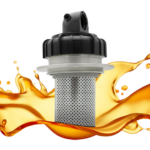By Josh Cosford, Contributing Editor
Microbes aren’t the most common contaminant in hydraulic oil, but they do become a problem when conditions are ripe for their proliferation. Anaerobic bacteria of various forms are the most common to be found within hydraulic fluid, although it’s not unheard of to see fungi (molds and yeasts) in very specific conditions. Regardless of the microbe species, they’re an annoying contaminant to deal with.
Microbes form almost exclusively in water-contaminated hydraulic fluid, as, like most Earthly lifeforms, they require H20 to survive. The warm, wet environment of a water-saturated reservoir makes a perfect home for self-replicating organisms to flourish. You must consider that everyday hydraulic systems do well at preventing microbial growth because they do not provide what the little prokaryotes need — water, food and stagnation.

The stagnation component is where most hydraulic systems gain the advantage over microbes — the pressure of circulating through the work lines of a machine certainly kills every lifeform outside of tardigrades. And the ones that make it are unlikely to find a restful place to reproduce. If you run hydraulic machinery in warm climates with the potential for water ingress, pay special attention, especially if your machines ever sit idle for long periods.
Microbial growth harms your hydraulic system in a few ways. During metabolization, microbes create acidic waste, which accelerates the chemical degradation of your oil. The result could be increased viscosity and degraded additives, which lead to poor machine performance, reduced efficiency and possible cavitation. Additionally, biofilm and sludge may form, providing their own symptoms, such as restricted flow or easily clogged filters that prematurely bypass.
Just like all forms of hydraulic fluid contamination, prevention is the best medicine. If you keep your hydraulic system dry, it’s unlikely microbes can grow. However, if you experience chronic water intrusion, there are common “drop-in” solutions.
A desiccant breather cap will trap moisture inhaled by your reservoir, keeping overall humidity down in what is otherwise a sealed system. With many conditions and under certain circumstances, the humidity of the air and the oil will equalize. Excessive air humidity will transfer water molecules to the oil, increasing the likelihood of free water to occur when atmospheric temperatures and pressures drop. By installing a desiccant breather cap, the air is dried before it can contaminate the hydraulic oil inside the reservoir.
Of course, should free water find its way into your hydraulic fluid, it must be removed as quickly as possible. Water-absorbing filter elements are an inexpensive option for removing free water from oil as the fluid passes through the assembly. Although old school water-removing elements use natural materials like cellulose, modern technology uses synthetic, superabsorbent polymers to achieve another level of dryness.
There is no such thing as oil being too dry, and because microbes require water to live and reproduce, there is no downside to ensuring water is prevented from contaminating your hydraulic system. Even if microbial growth isn’t a problem for your machine, dry oil allows your machine to run at its best, anyway.







Leave a Reply